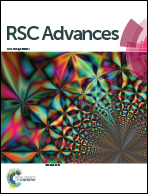Chemiluminescent properties of a fluorescent SiC·SiOx composite†
Abstract
Chemiluminescence (CL) happened in chemical reactions, in which electronically excited intermediates or products were obtained and subsequently released energy with emission of light. CL is a useful approach to investigate active radicals involved in one system. In the present work, we first found SiC·SiOx, a new kind of zero-dimensional silicon-based nanomaterial, owned CL properties in the presence of Ce(IV)–Na2SO3. The CL mechanism was further investigated by the CL, ultraviolet-visible light (UV-vis), and electron spin resonance (ESR) spectra. Mechanistic investigation indicated SiC·SiOx increased the generation of singlet oxygen in the Ce(IV)–Na2SO3 system and excited SiC·SiOx could be produced from the combination of hole and electron injected SiC·SiOx. This opens up an avenue for investigating the CL properties of SiC·SiOx and promotes their application in various fields.


 Please wait while we load your content...
Please wait while we load your content...